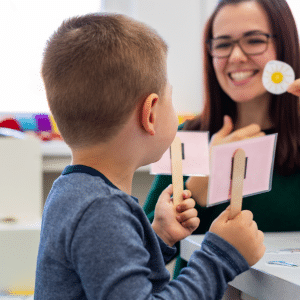How to Navigate the Key Speech Issues as an Early Years Practitioner: What Can Go Wrong, and What to Do About It
Karen Massey, Speech Therapist and CEO, All About Speech Therapy Ltd
5th January 2024
Share this entry:
As Speech and Language Therapists working with young children we come across many different issues relating to speech. Our ability to identify where the problems lie and to implement timely interventions can make a huge difference in a child’s development. Let’s cover some of those issues and what you as Early Years practitioners can do to help:
Late Talkers: One of the most common difficulties identified is a delay in saying first words, or having a limited vocabulary. For some children, like Evie, the difficulties lie in the words they can produce. Evie is able to understand what everyone else is saying but her own productions are minimal. For other children you may also see difficulties with understanding language. Joe not only has a limited spoken vocabula
In both cases, it is a good idea to monitor progress closely as you offer early intervention. Model language just beyond the level the child is already at, to scaffold their language skills to the next level. Think about teaching new words in different sensory ways – through real-life experience, play, songs and stories. Use frequent repetitions and praise each small step forwards. At the same time, it is a good idea to make your referral to the local Speech and Language Therapy team. They may be able to make more specific suggestions for intervention that accelerate Evie and Joe’s language progress.
Stammering: Another common aspect of preschool speech to be affected is the fluency of speech, where the flow is disrupted. You might notice certain sounds are repeated or lengthened, or perhaps the child stops then starts again. When Evie was still developing her expressive skills she often repeated sounds and words, as there was an imbalance between her ideas and her ability to form words. Whenever there is an imbalance in speech demand (high) and speech capacity (low) we might see stammering emerge. The encouraging thing to note is that this is frequently observed, and in most cases it will disappear before it becomes a longstanding problem.
It is key as a practitioner for you to be aware of strategies that take away the demands or pressure on the child, while thinking about the impact. For some children, like Evie, the impact was low and she was unaware when it happened; whereas other children can be more severely affected and they may become anxious around talking. Again, seeking professional speech and language therapy help via a referral is important to consider.
Social Communication differences – some children find it difficult to coordinate their verbal and nonverbal communication when interacting with other people. This may mean speaking without looking at you or sending the message to you clearly. When Ollie speaks he finds it uncomfortable to make eye contact, and he is so eager to have his turn in play that waiting is difficult too. You can support the understanding and development of adult-child interaction by following the children’s lead, helping them to develop turn-taking skills, and learning about their sensory processing style. This may mean high energy, noisy games, or it might mean calm, quiet times. Every child is different so your ability to observe and respond is key. If you are able to work with a sensory-trained Occupational Therapist they will give you some good pointers in this area. When children are regulated for sensory input, they can communicate more easily.
Speech clarity – It is typical for children in the Early Years to make errors with their speech sounds as their systems are still developing. But some children may have more of a difficulty producing sounds or using sounds accurately than others. Speech clarity might mean difficulties with organising sounds, listening to sounds and even hearing sounds, especially if glue ear is present during the winter months. It may be as a result of structural or oral motor needs.
If you know that a child has had a clear hearing test, there are some things you can do that might help. You can play listening and attention games, promote other mouth skills – chewing and blowing to develop strength and coordination of the mouth muscles. If you have concerns about hearing, you can suggest a referral to audiology.
Regardless of the nature of any difficulties, aim to access any available training, work with and support others around the child, especially parents and carers, as well as other professionals. Consider the bigger picture so that children receive holistic support. Early identification and intervention is nearly always best.
Find out more by visiting allaboutspeechtherapy.co.uk.
Why attend Childcare & Education Expo?
Join over 2,500 like-minded individuals from the early years & primary sector who are dedicated to improving their practice and their education settings.
Attend educational seminars and panel discussions to credit your CPD
Meet the experts to have your questions answered
Receive fantastic onsite offers and discounts
Experience expert-led informative hands-on workshops
Network with peers and industry players
Pick up hundreds of new products, resources, ideas and services
And most of all, enjoy a great day out with your colleagues




